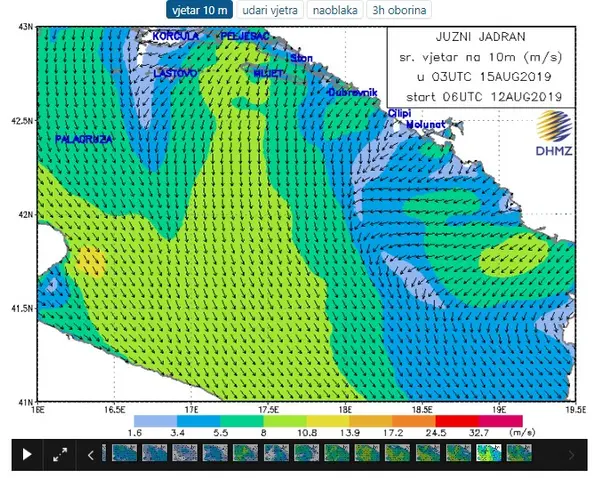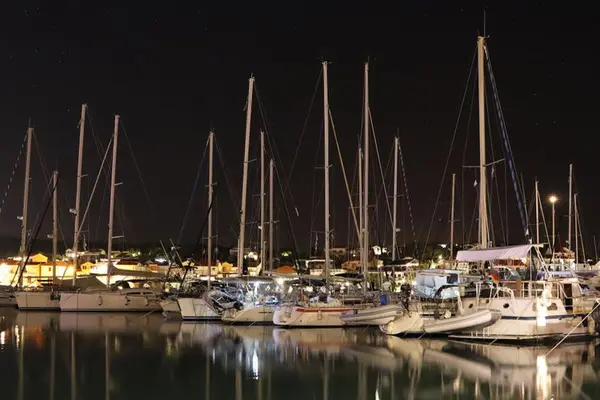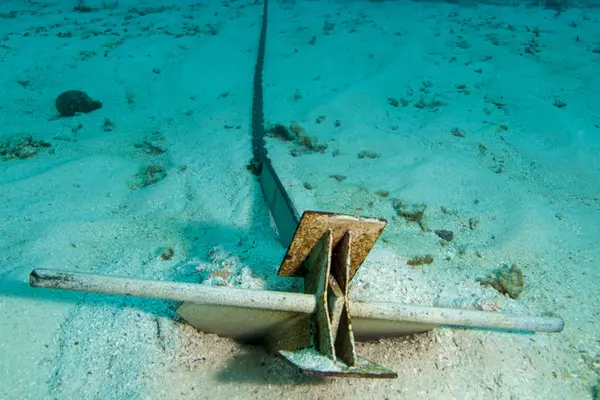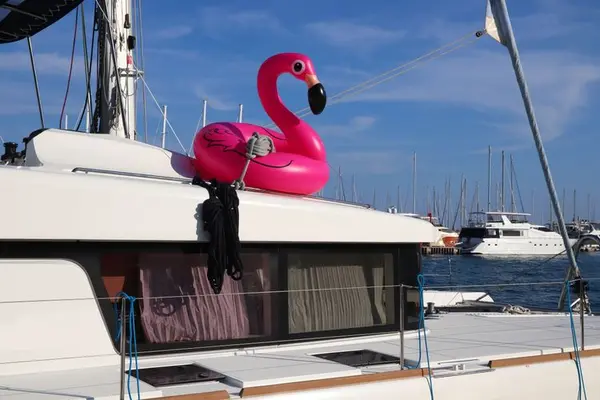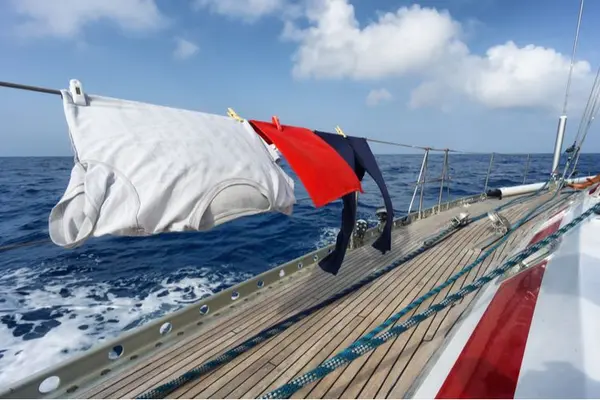YACHTING.COM TIP: Even if you are lucky enough to find out about a storm well in advance, you need to prepare for it thoroughly. So, how can you do this and what sailing technique should you choose? Read our complete guide on how to handle a boat in a storm.
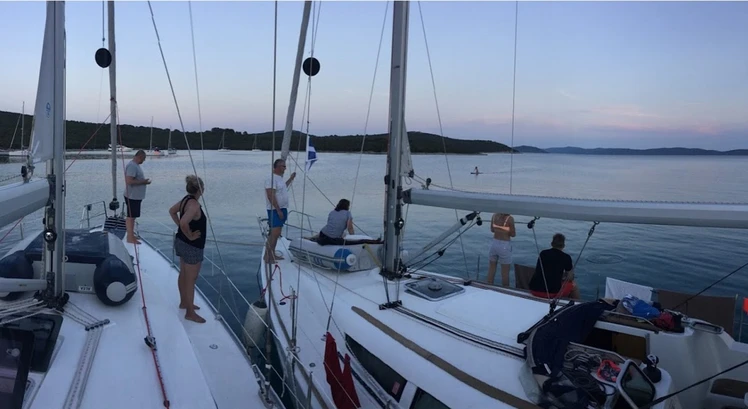 Sailboats at anchor in the bay of Molat
Sailboats at anchor in the bay of Molat18 tips to prepare for mooring in a storm whilst minimizing risk
The situation as described above is far from unrealistic in summer. Perhaps you've found yourself in a similar scenario already but if not, you really don’t want to experience it. Not the storm so much, but the hopelessness of the overall situation on board, when you are at a loss what to do first. Documentation on maritime accidents shows that the weakest link is not the failure of technology, but the human factor. A small error or inconsistency with the little things can end up causing a tragedy.
1. Be consistent
Those who are consistent in their own life should be twice as consistent at sea. Those who are not consistent, at least ten times more. :-) If you think you should do it on board, just do it. And immediately. This applies to both navigation and mooring. And it's really worth it.
2. Monitor the meteorological situation
Always keep an eye on local meteorological conditions, even in calm weather. And do it even if you are getting continuous SMS weather updates. Most sailors like to use the Windy app. I don't want to discourage you because it's a great app, but there are a few things to take into consideration. It is a forecasting program, so it does not say what the current situation at sea is, but "calculates" the situation in the atmosphere. It is a global forecast that works with a certain data density, according to each prediction model. For example, the GFS model has a data density of 27 kilometres (15 nautical miles). So, logically, it cannot outline the situation in your bay, given the surrounding islands, because it simply cannot see them. Use custom analysis and local weather servers (see the links below the article).
3. Choose a good location
Choose a location for the night where the expected night wind would direct your stern away from the bay and push you towards the open sea rather than onto the cliffs. Otherwise, in strong winds at night, it would be difficult to leave the bay, especially with a less powerful sailboat motor. If you are not sure that you can handle the situation in the bay, choose a safe harbour instead.
If the marinas are already full or closed and there is no suitable bay to moor at nearby, sail away from the islands to the open sea. The crew will hate you, but at least you'll all survive. In the open sea, sailboats simply do not sink. It is no coincidence that the cardinal rule of seamanship is "Protect your ship from the shore, and it will protect you from the sea".
4. Allow for gusts of wind
A storm brings gusts of wind. What is a gust of wind? It is a locally amplified wind due to the orography (shape) of the terrain or due to a locally amplified pressure gradient. Sometimes predicting gusts can be done by simple observation with your own eyes, for example, based on the shape of the bay or the surrounding hills. In any case, a simple empirical equation holds that a gust can increase the wind speed up to three times under certain conditions. So a forecast promising a 30-knot wind at night (56 km/h) can also bring 70-knot gusts (130 km/h).
5. Mooring buoy or anchor?
There has been a long-running debate amongst mariners as to whether an anchor or buoy is better and what procedures to choose. In fact, it's such a huge topic that it could take up a whole article in itself. In the case of a buoy, always tie on two ropes, each returning to the same cleat. Each year, there are several documented cases of ropes chafing and breaking away from the buoy. Always anchor the sailboat (with a chain length of at least five times the depth) at full reverse thrust (approx. 2400 rpm depending on engine type). The anchor has to hold to ensure a peaceful sleep. In Croatia, do not anchor at depths greater 10 metres. Use an anchor buoy at anchor, display the circular black anchoring day shape during the day and turn on the masthead light at night.
YACHTING.COM TIP: Know how to moor a boat safely on a buoy or at a pier and how moorings work? Check out our ultimate guide to mooring: how to moor your boat correctly and safely. And go over the 9 essential sailing knots.
6. Check below the surface
Don’t be lazy when anchoring or at a buoy, dive and check that everything is OK under the surface. If you can not dive to the seabed, at least take a look using goggles and snorkel from the surface. Regarding a buoy, don’t just check its lower eye, also check whether the buoy rope is not worn and is attached securely to the concrete block. At anchor, make sure you did not drop it into the underwater grass and check that it is fully secured to the sea bed. Do not just presume the anchor is lying on the bed and you have enough chain.
7. Use fenders
Take out the fenders from below deck or untie them from the flat end of the stern where you are tied and then attach them to both sides of the boat. This will minimise damage in case any of the neighbouring boats break free at night.
8. Pull the dinghy on deck
A common mistake made by many recreational sailors is to pull the dinghy behind the boat. Likewise, in bays and marinas, you can often see boats moored at night with dinghies on the water at the stern or bow. Don’t be apathetic, always pull the boat aboard and secure it there with ropes. It is one of many things that can get revenge on you and really complicate the situation. Understandably, the crew will argue that they have just returned from the pub in the evening and will set off for some fresh bread in the morning. But … the dinghy belongs on the boat, so be consistent.
9. Secure loose items on deck
During a summer voyage, you’ll find yourself with many things on deck that would get in the way below deck or simply just won’t fit there. Make sure to secure them all firmly on board and in order to do this, it’s best to take along a number of short pieces of rope and bungee cords (about 1–2 metres in length). If you don't have them with you, you can find them in local stores in most marinas. Be careful when tying down the paddelboard or walkway. They should always be on the opposite side to where the genoa furling line leads to avoid collision or jamming of the line. Also tie your inflatables down (such as the aforementioned pink flamingo), store them in the hold or deflate them. Among other things, so as not to block access to the anchor well.
10. Drying linen on board
Never let anyone on the boat hang linen out to dry on free moving ropes (lifts and sheets). The sail sheets may appear perfect "lines" for hanging clothes but just imagine what a swimsuit stuck in the sheets pulley might cause. If something needs to be dried, use the boat's railing for this purpose. And take down all the laundry for the night.
11. Tidy up the cockpit and below deck
Keep your deck in order and especially the cockpit before going to bed. Wine glasses and scattered peanuts may backfire at night. The same applies to below deck. Make sure the crew check that nothing is free to roll around below deck. Since the cabins are private spaces, the crew can keep order as they see fit. The captain's table is your private space for maps and logbook, or for charging mobile phones. It certainly should not serve as an extended kitchen area, for example, to cut onions.
12. Transmitter and instruments
Leave the radio on channel 16 and the basic instruments switched on overnight. These are mainly tridata (depth and wind speed). When dealing with a drama, it frees your hands up and you won’t have to waste valuable time waiting for the devices to start up. Find out in advance how the depth gauge is set up. Whether it measures from the transducer or has a predefined offset (i.e., offset to the measured depth), for example, from the lower edge of the keel. In some dramatic situations, every centimetre of depth counts.
13. Track position / use an anchor alarm
Use the anchor alarm (a program that shows you the distance from the assumed anchor position). Alternatively, keep location tracking turned on (e.g. via Navionics). This is the only way to determine if your anchored boat is drifting even with the anchor in a strong wind. Tracking with your device's display (mobile or tablet) turned off uses minimal power consumption and can track your location all night long.
14. Bimini and sprayhood
At 8 on the Beaufort scale, which is a wind speed of 34 to 40 knots (62–74 km/h), a force of up to 270 N is applied on each square metre of the exposed surface of the boat or any object on the boat. That is to say a force equivalent to 28 kilograms. And this doesn’t take into account any gusts of wind. In the case of a 16-metre boat at anchor or buoy in a side wind, it is equivalent to about one tonne of force. Therefore, if the forecast is poor, always fold down the bimini top (which primarily serves as sun protection) in time. It can get torn and unnecessarily increases your wind resistance. Keep the sprayhood up as it is relatively aerodynamic and better reinforced. It also serves as good protection against water spray.
15. Furl the genoa
Check that the genoa is fully in and that you have at least two turns on the sheets. In the Adriatic Sea, you can often see sailboats in harbours that have the aesthetically pleasing triangle of the genoa above the bow, with slack sheets running from it. The tip of this sail can cause quite serious problems in strong winds. Aside from the fact that it is another area on which the wind catches, the wind can unexpectedly pull the entire sail out when the roller furling line is unsecured.
16. Night watch
If required, divide up the night watch on board. As captains, save yourself and make sure you are completely fresh and ready to intervene when needed.
17. Keep a clear head
Bear in mind that alcohol can significantly distort your judgement. Alcohol on board is a hot topic among sailors, but we don't have time here to delve into it in more detail here.
18. Final advice — don't panic!
Behave in a calm and balanced way in even the most dramatic of situations. Running around in confusion on deck can lead to injury. In extreme situations, the crew will be fully dependent on you and can read your facial expressions. Therefore it is best to use your “poker face”. Never let it be known that you don’t know what to do in a situation. It will unsettle your crew which, in turn, will unnerve you even more. If you look composed, they won't panic. Otherwise, they might prefer to voluntarily jump into the stormy sea just to ease their suffering.
Preparing for a stormy night is a complex topic. Follow the above recommendations and they’ll bring you a more peaceful sleep and make it easier to deal with any drama that may unfold.
What else might come in handy?
Here are some meteorological links with a local forecast. In our experience, using them really pays off.
Author: Pavel Kocych

 Night storm in the Adriatic Sea
Night storm in the Adriatic Sea 

